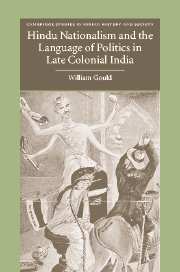Book contents
- Frontmatter
- Contents
- Acknowledgements
- Glossary
- List of abbreviations
- 1 Introduction
- 2 Congress and the Hindu nation: symbols, rhetoric and action
- 3 Muslims, mass movements and untouchable uplift
- 4 The Aryan Congress: history, youth and the ‘Hindu race’
- 5 Congress radicals and Hindu militancy
- 6 Congress ‘Raj’, riots and Muslim mass contacts
- 7 Congress, Pakistan and volunteer militarism
- 8 Conclusion
- Bibliography
- Index
- Other titles in the series
2 - Congress and the Hindu nation: symbols, rhetoric and action
Published online by Cambridge University Press: 11 July 2009
- Frontmatter
- Contents
- Acknowledgements
- Glossary
- List of abbreviations
- 1 Introduction
- 2 Congress and the Hindu nation: symbols, rhetoric and action
- 3 Muslims, mass movements and untouchable uplift
- 4 The Aryan Congress: history, youth and the ‘Hindu race’
- 5 Congress radicals and Hindu militancy
- 6 Congress ‘Raj’, riots and Muslim mass contacts
- 7 Congress, Pakistan and volunteer militarism
- 8 Conclusion
- Bibliography
- Index
- Other titles in the series
Summary
In attempting to investigate the nature and operation of symbolic communication in north India, it is useful to locate a historical point at which local and national politics intersected. In Uttar Pradesh, one such moment of intersection was the urban and rural protests of 1930–4. The civil disobedience movement of this period is regarded as the second period of mass nationalist protest in India, following the non-cooperation of 1920–2. It was built upon long and careful preparation throughout 1929. Civil disobedience aimed to create mass enthusiasm for the nation and the propagation of the main political issue of ‘purna swaraj’ (perfect freedom) was achieved in practice by the transformation of local protests on the basis of an India-wide nationalist symbolism. This symbolism and nationalist imagery were an answer to the political divergence of differentiated local and provincial interest groups. The salt tax issue was the first and most famous example, but throughout 1930–4 other symbolic themes arose as part of a planned campaign which linked the activities of district Congress workers with negotiations at the centre. Localised disputes and grievances were harnessed, facilitated by the effects of economic depression. Congress workers in UP visited pockets of rural and urban discontent, where specific complaints were varied – ranging from disputes over landownership or rents to licences for markets or processions. The tactics used to harness local grievances very often aimed to restrain and check as much as to develop militancy.
- Type
- Chapter
- Information
- Publisher: Cambridge University PressPrint publication year: 2004
- 1
- Cited by



